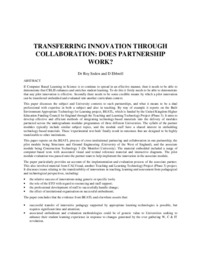| dc.contributor.author | Seden, Roy | en |
| dc.contributor.author | Ebbrell, D. | en |
| dc.coverage.spatial | Czech Republic | en |
| dc.creator | Seden, Roy | en |
| dc.creator | Ebbrell, D. | en |
| dc.date.accessioned | 2016-03-02T06:38:33Z | |
| dc.date.available | 2016-03-02T06:38:33Z | |
| dc.date.issued | 2001 | |
| dc.identifier.uri | http://hdl.handle.net/10797/14839 | |
| dc.description | Περιέχει το πλήρες κείμενο | el |
| dc.description.abstract | If Computer Based Learning in Science is to continue to spread in an effective manner, then it needs to be able to
demonstrate that CBLIS enhances and enriches student learning. To do this it firstly needs to be able to demonstrate
that any pilot innovation is effective. Secondly there needs to be some credible means by which a pilot innovation
can be transferred embedded and evaluated into another curriculum context.
This paper discusses the subject and University contexts to such partnerships, and what it means to be a dual
professional with expertise in both a subject and also in teaching. By way of example it reports on the Built
Environment Appropriate Technology for Learning project, BEATL, which is funded by the United Kingdom Higher
Education Funding Council for England through the Teaching and Learning Technology Project (Phase 3). It aims to
develop effective and efficient methods of integrating technology-based materials into the delivery of modules
partnered across the undergraduate modular programmes of three different Universities. The syllabi of the partner
modules typically include similar subject topics, and the module staff have a shared interest in embedding
technology-based materials. These 'experimental test-beds' finally result in outcomes that are designed to be highly
transferable to other institutions.
This paper reports on the BEATL process of cross-institutional partnering and collaboration in one partnership, the
pilot module being Structures and Ground Engineering (University of the West of England), and the associate
module being Construction Technology 3 (De Montfort University). The material embedded included a range of
computer-based tests with associated visual and textual reference material and interactive diagrams. The pilot
module evaluation was passed onto the partner team to help implement the innovation in the associate module.
The paper particularly provides an account of the implementation and evaluation process of the associate partner.
This also involved material from CALVisual, another Teaching and Learning Technology Project (Phase 3) project.
It discusses issues relating to the transferability of innovations in teaching, learning and assessment from pedagogical
and technological perspectives, including:
• the relative success of innovations using generic or specific tools;
• the role of the ETO with regard to resourcing and staff support;
• the professional development of staff to successfully handle change;
• the effect of institutional organisation on successful embedment;
The paper concludes that the evidence from BEATL and elsewhere asserts that:
• successful transfer of innovative pedagogy supported by appropriate learning technologies is possible, but
requires significant time and attention;
• associated embedment and evaluation methodologies could be of generic value to Universities seeking to
enhance their student learning experience in response to changes generated by the ever gathering W, C & IT revolution. | en |
| dc.language.iso | eng | en |
| dc.publisher | Pedagogical Faculty of University of Ostrava | en |
| dc.relation.ispartof | Teaching packages 2 | en |
| dc.rights | info:eu-repo/semantics/openAccess | en |
| dc.rights | Open Access | en |
| dc.source | CBLIS Conference Proceedings 2001 Computer based learning in science | en |
| dc.title | Transferring innovation through Collaboration: does partnership Work? | en |
| dc.type | info:eu-repo/semantics/conferenceObject | en |
| dc.contributor.conferenceorganizer | Masaryk University, Faculty of education, Brno | en |
| dc.contributor.conferenceorganizer | University of Ostrava, Pedagogical Faculty | en |
| dc.contributor.coordinator | Constantinou, Constantinos P. | en |
